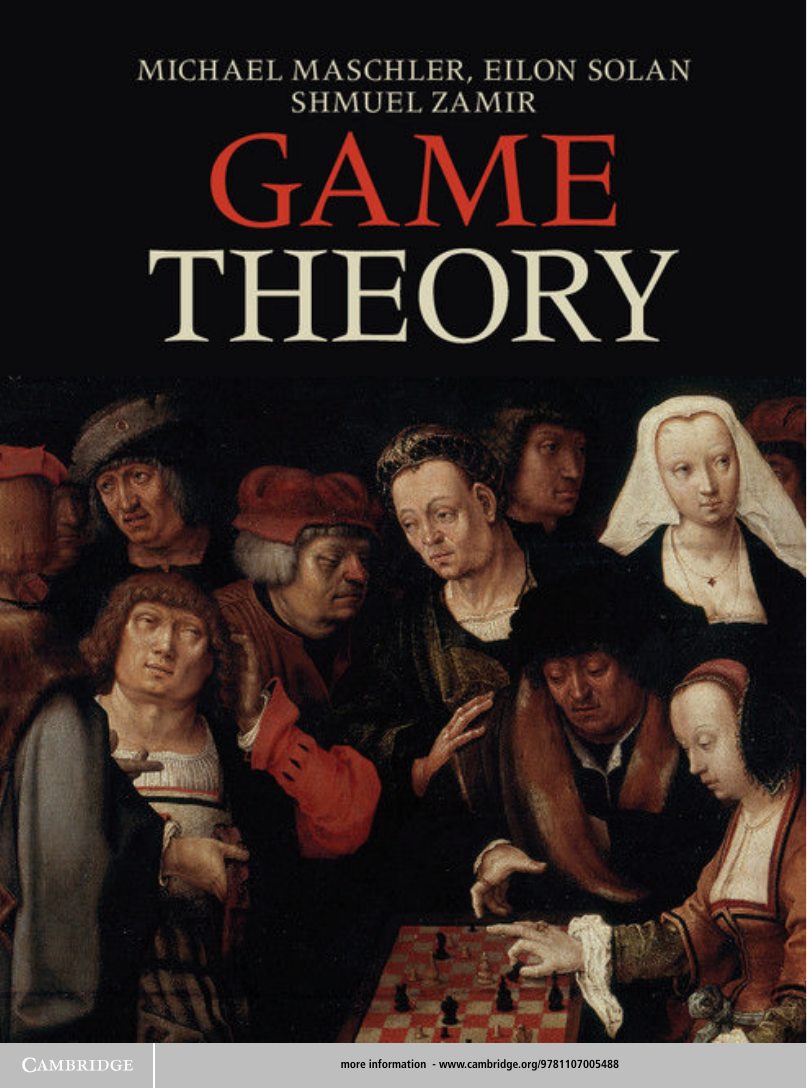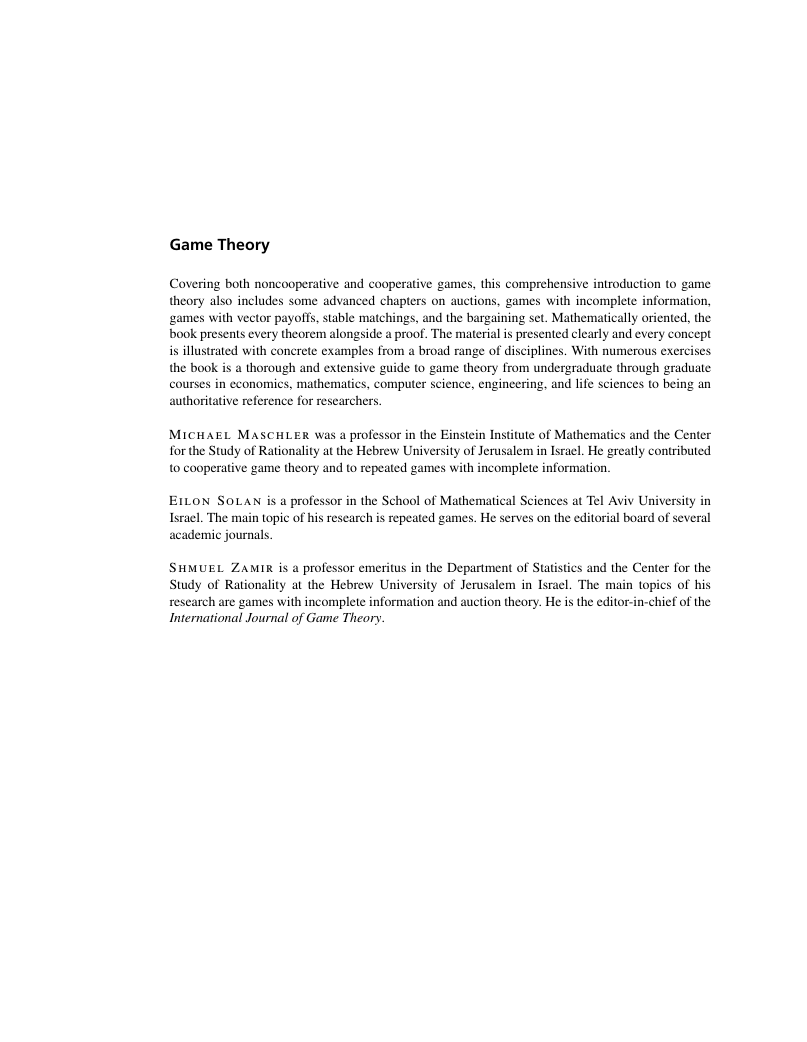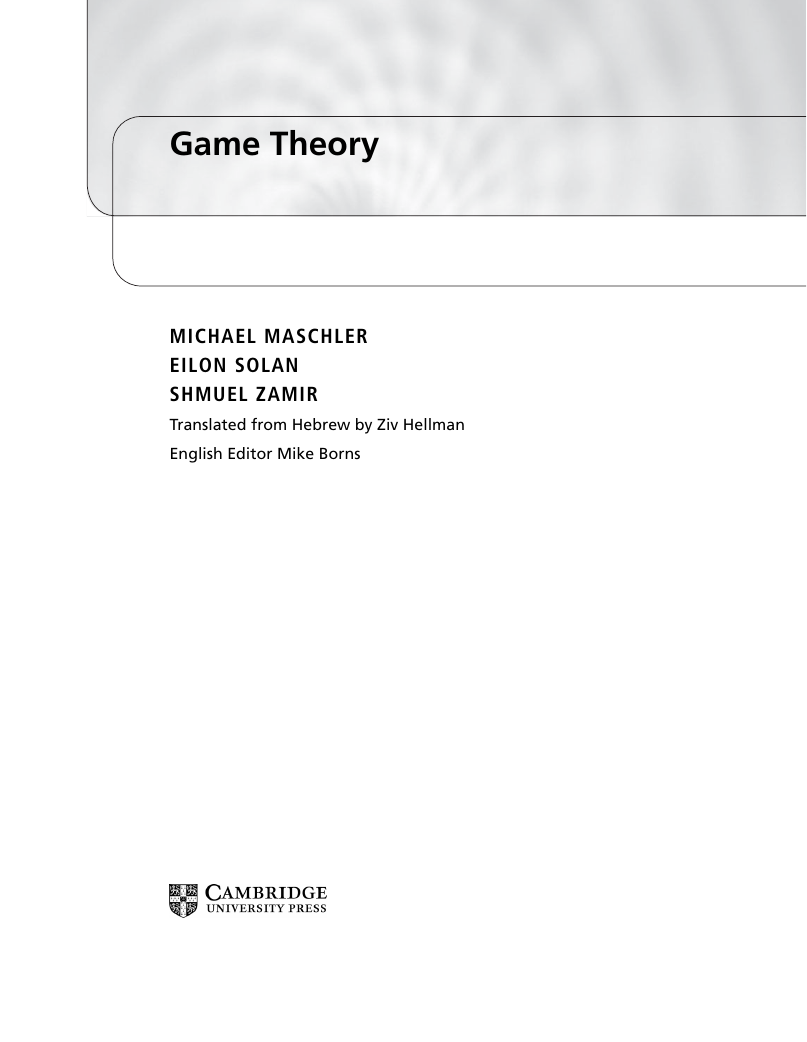Contents
Acknowledgments
Notations
Introduction
What is game theory?
How to use this book
1 The game of chess
Chapter summary
1.1 Schematic description of the game
1.2 Analysis and results
1.3 Remarks
1.4 Exercises
2 Utility theory
Chapter summary
2.1 Preference relations and their representation
2.2 Preference relations over uncertain outcomes
2.3 The axioms of utility theory
2.3.1 Continuity
2.3.2 Monotonicity
2.3.3 Simplification of lotteries
2.3.4 Independence
2.4 The characterization theorem
2.5 Utility functions and affine transformations
2.6 Infinite outcome set
2.7 Attitude towards risk
2.8 Subjective probability
2.9 Discussion
2.9.1 The assumption of completeness
2.9.2 The assumption of transitivity
2.9.3 Perceptions of probability
2.9.4 The Axiom of Simplification
2.9.5 Other aspects that can influence preferences
2.10 Remarks
2.11 Exercises
3 Extensive-form games
Chapter summary
3.1 An example
3.2 Graphs and trees
3.3 Game trees
3.4 Chomp: David Gale's game
3.5 Games with chance moves
3.6 Games with imperfect information
3.6.1 Strategies in games with imperfect information
3.7 Exercises
4 Strategic-form games
Chapter summary
4.1 Examples and definition of strategic-form games
4.2 The relationship between extensive and strategic forms
4.3 Strategic-form games: solution concepts
4.4 Notation
4.5 Domination
4.6 Second-price auctions
4.7 The order of elimination of dominated strategies
4.8 Stability: Nash equilibrium
4.9 Properties of the Nash equilibrium
4.9.1 Stability
4.9.2 A self-fulfilling agreement
4.9.3 Equilibrium and evolution
4.9.4 Equilibrium from the normative perspective
4.10 Security: the maxmin concept
4.11 Elimination of dominated strategies
4.12 Two-player zero-sum games
4.13 Games with perfect information
4.14 Games on the unit square
4.14.1 A two-player zero-sum game on the unit square
4.14.2 A two-player non-zero-sum game on the unit square
4.15 Remarks
4.16 Exercises
5 Mixed strategies
Chapter summary
5.1 The mixed extension of a strategic-form game
5.2 Computing equilibria in mixed strategies
5.2.1 The direct approach
5.2.2 Computing equilibrium points
5.2.3 The indifference principle
5.2.4 Dominance and equilibrium
5.2.5 Two-player zero-sum games and linear programming
5.2.6 Two-player games that are not zero sum
5.3 The proof of Nash's Theorem
5.4 Generalizing Nash's Theorem
5.5 Utility theory and mixed strategies
5.6 The maxmin and the minmax in n-player games
5.7 Imperfect information: the value of information
5.8 Evolutionarily stable strategies
5.9 Remarks
5.10 Exercises
6 Behavior strategies and Kuhn's Theorem
Chapter summary
6.1 Behavior strategies
6.2 Kuhn's Theorem
6.2.1 Conditions for the existence of an equivalent mixed strategy to any behavior strategy
6.2.2 Representing (x;) as a product of probabilities
6.2.3 Proof of the second direction of Theorem 6.11: sufficiency
6.2.4 Conditions guaranteeing the existence of a behavior strategy equivalent to a mixed strategy
6.3 Equilibria in behavior strategies
6.4 Kuhn's Theorem for infinite games
6.4.1 Definitions of pure strategy, mixed strategy, and behavior strategy
6.4.2 Equivalence between mixed strategies and behavior strategies
6.4.3 Statement of Kuhn's Theorem for infinite games and its proof
6.5 Remarks
6.6 Exercises
7 Equilibrium refinements
Chapter summary
7.1 Subgame perfect equilibrium
7.2 Rationality, and backward and forward induction
7.3 Perfect equilibrium
7.3.1 Perfect equilibrium in strategic-form games
7.3.2 Perfect equilibrium in extensive-form games
7.4 Sequential equilibrium
7.5 Remarks
7.6 Exercises
8 Correlated equilibria
Chapter summary
8.1 Examples
8.2 Definition and properties of correlated equilibrium
8.3 Remarks
8.4 Exercises
9 Games with incomplete information and common priors
Chapter summary
9.1 The Aumann model and the concept of knowledge
9.2 The Aumann model with beliefs
9.3 An infinite set of states of the world
9.4 The Harsanyi model
9.4.1 Belief hierarchies
9.4.2 Strategies and payoffs
9.4.3 Equilibrium in games with incomplete information
9.5 A possible interpretation of mixed strategies
9.6 The common prior assumption
9.7 Remarks
9.8 Exercises
10 Games with incomplete information: the general model
Chapter summary
10.1 Belief spaces
10.2 Belief and knowledge
10.3 Examples of belief spaces
10.4 Belief subspaces
10.5 Games with incomplete information
10.6 The concept of consistency
10.7 Remarks
10.8 Exercises
11 The universal belief space
Chapter summary
11.1 Belief hierarchies
11.2 Types
11.3 Definition of the universal belief space
11.4 Remarks
11.5 Exercises
12 Auctions
Chapter summary
12.1 Notation
12.2 Common auction methods
12.3 Definition of a sealed-bid auction
12.4 Equilibrium
12.5 The symmetric model
12.5.1 Analyzing auctions: an example
12.5.2 Equilibrium strategies
12.5.3 The Revenue Equivalence Theorem
12.5.4 Entry fees
12.6 The Envelope Theorem
12.7 Risk aversion
12.8 Mechanism design
12.8.1 The revelation principle
12.8.2 The Revenue Equivalence Theorem
12.9 Individually rational mechanisms
12.10 Finding the optimal mechanism
12.11 Remarks
12.12 Exercises
13 Repeated games
Chapter summary
13.1 The model
13.2 Examples
13.3 The T-stage repeated game
13.3.1 Histories and strategies
13.3.2 Payoffs and equilibria
13.3.3 The minmax value
13.4 Equilibrium payoffs of the T-stage repeated game
13.4.1 Proof of the Folk Theorem: example
13.4.2 Detailed proof of the Folk Theorem
13.5 Infinitely repeated games
13.6 The discounted game
13.7 Uniform equilibrium
13.8 Discussion
13.9 Remarks
13.10 Exercises
14 Repeated games with vector payoffs
Chapter summary
14.1 Notation
14.2 The model
14.3 Examples
14.4 Approachable and excludable sets
14.5 The approachability of a set
14.6 Characterizations of convex approachable sets
14.7 Application 1: Repeated games
14.8 Application 2: Challenge the expert
14.8.1 The model
14.8.2 Existence of a no-regret strategy: a special case
14.8.3 Existence of a no-regret strategy: the general case
14.9 Discussion
14.10 Remarks
14.11 Exercises
15 Bargaining games
Chapter summary
15.1 Notation
15.2 The model
15.3 Properties of the Nash solution
15.3.1 Symmetry
15.3.2 Efficiency
15.3.3 Covariance under positive affine transformations
15.3.4 Independence of irrelevant alternatives (IIA)
15.4 Existence and uniqueness of the Nash solution
15.5 Another characterization of the Nash solution
15.5.1 Interpersonal comparison of utilities
15.5.2 The status quo region
15.6 The minimality of the Nash solution
15.7 Critiques of the properties of the Nash solution
15.8 Monotonicity properties
15.9 Bargaining games with more than two players
15.10 Remarks
15.11 Exercises
16 Coalitional games with transferable utility
Chapter summary
16.1 Examples
16.1.1 Profit games
16.1.2 Cost games
16.1.3 Simple games
16.1.4 Weighted majority games
16.1.5 Market games
16.1.6 Sequencing games
16.1.7 Spanning tree games
16.1.8 Cost-sharing games
16.2 Strategic equivalence
16.3 A game as a vector in a Euclidean space
16.4 Special families of games
16.5 Solution concepts
16.6 Geometric representation of the set of imputations
16.7 Remarks
16.8 Exercises
17 The core
Chapter summary
17.1 Definition of the core
17.2 Balanced collections of coalitions
17.3 The Bondareva--Shapley Theorem
17.3.1 The Bondareva--Shapley condition is a necessary condition for the nonemptiness of the core
17.3.2 The Bondareva--Shapley condition is a sufficient condition for the nonemptiness of the core
17.3.3 A proof of the Bondareva--Shapley Theorem using linear programming
17.4 Market games
17.4.1 The balanced cover of a coalitional game
17.4.2 Every totally balanced game is a market game
17.5 Additive games
17.6 The consistency property of the core
17.7 Convex games
17.8 Spanning tree games
17.9 Flow games
17.10 The core for general coalitional structures
17.11 Remarks
17.12 Exercises
18 The Shapley value
Chapter summary
18.1 The Shapley properties
18.1.1 Efficiency
18.1.2 Symmetry
18.1.3 Covariance under strategic equivalence
18.1.4 The null player property
18.1.5 Additivity property
18.2 Solutions of some of the Shapley properties
18.3 The definition of the Shapley value
18.4 Examples
18.5 An alternative characterization
18.5.1 The marginality property
18.5.2 The second characterization of the Shapley value
18.6 Application: the Shapley-Shubik power index
18.6.1 The power index of the United Nations Security Council
18.7 Convex games
18.8 The consistency of the Shapley value
18.9 Remarks
18.10 Exercises
19 The bargaining set
Chapter summary
19.1 Definition of the bargaining set
19.2 The bargaining set in two-player games
19.3 The bargaining set in three-player games
19.4 The bargaining set in convex games
19.5 Discussion
19.6 Remarks
19.7 Exercises
20 The nucleolus
Chapter summary
20.1 Definition of the nucleolus
20.2 Nonemptiness and uniqueness of the nucleolus
20.3 Properties of the nucleolus
20.4 Computing the nucleolus
20.5 Characterizing the prenucleolus
20.6 The consistency of the nucleolus
20.7 Weighted majority games
20.8 The bankruptcy problem
20.8.1 The model
20.8.2 The case n=2
20.8.3 The case n>2
20.8.4 The nucleolus of a bankruptcy problem
20.9 Discussion
20.10 Remarks
20.11 Exercises
21 Social choice
Chapter summary
21.1 Social welfare functions
21.2 Social choice functions
21.3 Non-manipulability
21.4 Discussion
21.5 Remarks
21.6 Exercises
22 Stable matching
Chapter summary
22.1 The model
22.2 The men's courtship algorithm
22.3 The women's courtship algorithm
22.4 Comparing matchings
22.4.1 The lattice structure of the set of stable matchings
22.5 Extensions
22.5.1 When the number of men does not equal the number of women
22.5.2 Strategic considerations
22.5.3 The desire to remain single, or: getting married, but not at any price
22.5.4 Polygamous matching: placement of students in universities
22.5.5 Unisexual matchings
22.6 Remarks
22.7 Exercises
23 Appendices
Chapter summary
23.1 Fixed point theorems
23.1.1 Sperner's Lemma
23.1.2 Brouwer's Fixed Point Theorem
23.1.3 Kakutani's Fixed Point Theorem
23.1.4 The KKM Theorem
23.2 The Separating Hyperplane
23.3 Linear programming
23.4 Remarks
23.5 Exercises
References
Index
















 2023年江西萍乡中考道德与法治真题及答案.doc
2023年江西萍乡中考道德与法治真题及答案.doc 2012年重庆南川中考生物真题及答案.doc
2012年重庆南川中考生物真题及答案.doc 2013年江西师范大学地理学综合及文艺理论基础考研真题.doc
2013年江西师范大学地理学综合及文艺理论基础考研真题.doc 2020年四川甘孜小升初语文真题及答案I卷.doc
2020年四川甘孜小升初语文真题及答案I卷.doc 2020年注册岩土工程师专业基础考试真题及答案.doc
2020年注册岩土工程师专业基础考试真题及答案.doc 2023-2024学年福建省厦门市九年级上学期数学月考试题及答案.doc
2023-2024学年福建省厦门市九年级上学期数学月考试题及答案.doc 2021-2022学年辽宁省沈阳市大东区九年级上学期语文期末试题及答案.doc
2021-2022学年辽宁省沈阳市大东区九年级上学期语文期末试题及答案.doc 2022-2023学年北京东城区初三第一学期物理期末试卷及答案.doc
2022-2023学年北京东城区初三第一学期物理期末试卷及答案.doc 2018上半年江西教师资格初中地理学科知识与教学能力真题及答案.doc
2018上半年江西教师资格初中地理学科知识与教学能力真题及答案.doc 2012年河北国家公务员申论考试真题及答案-省级.doc
2012年河北国家公务员申论考试真题及答案-省级.doc 2020-2021学年江苏省扬州市江都区邵樊片九年级上学期数学第一次质量检测试题及答案.doc
2020-2021学年江苏省扬州市江都区邵樊片九年级上学期数学第一次质量检测试题及答案.doc 2022下半年黑龙江教师资格证中学综合素质真题及答案.doc
2022下半年黑龙江教师资格证中学综合素质真题及答案.doc